Zaamurets (1916)
 Russia 1916-1932. The "far east monster"
Russia 1916-1932. The "far east monster"Alias "Lenin", "BP No.4", "Polipanovtsi", "Olrik", "Train No. 105".
Origin
Zaamurets is certainly one of the most famous armoured train that was ever built, perhaps less because of its strenght or composition, but more due to its very long career and properly amazing story, crossing an immense continent. Zaamurets indeed went under several names, changing hands many times, being damaged, repaired, refitted, grew from various additions and other trains to become a truly fascinating monster armoured train seeding terror from eastern Europe and into China.Zaamurets was originally built by the Russian army, some sources states in 1915 and others that it was completed in Odessa by 1916 and entered service with the Russian Imperial Army in October. It first saw action in Galicia, was catpured by the reds in 1918, renamed "Lenin", combined to another train (Khunkhuz-type BP No.3) as "BP No.4" and used on the Trans-Siberian Railway to combat the Czechoslovak Legion, but captured by them and renamed "Orlik" by July 1918. It retreated to Vladivostok and entered the Chinese Eastern Railway by April 1920, was captured by the IJA at Hailar (Inner Mongolia), but Ōi Shigemoto gave it back to the Legion in Harbin. The Legion left for home and it was guven to the White Russians by September 1920, fighting with the Fengtian clique from mandchuria, and fought long and hard in the warlord eran, until captured by the Kwantung Army in 1931, renamed Train No. 105, and disappeared without traces.

Zaamurets/Orlik is generally believed to have fought during the warlord ear under the Russian detachment of General Nechaev, used as mercenary under Marshal Zhang Zuchang in 1924-1928. It was perhaps confounded with the "Peking" armored train built in 1926 in Tsinan (Jinan) workshop by Russian engineers from Harbin which worked also on Zaamurets. Archives and photos (M. Blinov) saw relatively close trains, but they were separate.
Design
Original
Zaamurets was a multicar train composed of a locomotive and coal trailer, both semi-armoured, and pushing forward the main and most recoignisable element, a heavy and laegr four bogies main armoured wagon, featuring multiple machine gun positions (forward and aft on corners, two each and four on the sides, either sides in casemates, for eight total and two fully-traversable 57-mm turrets under cupola like turrets powered by electric motors. The whole central section had a rounded roof and it was covered at least by 8 mm (0.3 inches) steel plating, bolted, all over to protect the crew from small arms fire. Protection ranged from 12mm up to 16mm of armour. The two turrets could rotate 360 degreesand the main Nordenfelt guns could elevate +10 degrees, -60 degrees. The main guns were supplemented with eight machine guns.Uniquely also, this cruiser like railway car also had two high-powered Italian 60-hp petrol motors that can independently push it to 28 miles per hour (45 kph) in case of separation. The initial turrets were relatively low, and were ventilated by several fume extractor funnel-like vents. There were also mushroom like ventilation domes in the central crew section (with common beds, a kitchen, a small lavatory and storage). The crew at the time was probably around 50-70 men, between the eight MG gunners, five for each 57 mm gun, and the rest as mobile platoon, an officer and his staff and some service personnel. The train car was painted standard live green, with painted red name "zaamurets" below one turret.
At the time this was the most advanced armored car train ever built in Russia, with innovations such as the two hemispheric turret for better protection as well as sloped armour, self propelled with powerful and modern gasoline engines, rangefinders and periscopes for its artillery, naval Nordenfelt automatic, quick firing guns, and internal telephones plus a central ventilation system.
As "Olrik"
The recaptured Zaamurets kept the locomotive and main fighting railway car, but was added two closed artillery wagons each with a gun in frontal barbette, two machine guns posts on each side and several pistol ports with shutters. The steam powered locomotive received a better protection with additional steel plating, plus flatbed train cars were added to both ends to prevent derailing. The first, main artillery train car, forward of the locomotive received updated, raised and revised main turrets, raised for better clearance. The guns changed to two more modern and long range 76-mm Putilov anti-aircraft cannons plus lookout structures used for gunnery spotting and corrections. Portholes and casemates for small arms, machine guns remained unchanged as the two main access hatches close to the turrets. The central ventilation system was improved. This was done by Workers at Odessa, starting in September 1917.The two other artillery wagons later were upgraded. One, at the end of the train and before the safety flatbed car, received a conical gun turret with the same 75 mm gun. Top speed of the whole train reached 45 kmh for 130 tons. Until 1917, the Russian Army deployed it on the southwest front as Zaamurets and by March 1918, it was passed onto the Red Guard units under Commander Polipanov, renamed "armored train No. 4" and more colloquially "Polipanovtsi". Some sources states that that was then where eight periscopes were added as well as a new intercom system and signalling equipment, plus searchlights on both ends as well as range finders. The seachlights were later removed and when the train became the Czech "olrik" (eagle). The name was painted in small white letters close to the other turret. The name was repeated on the two other armed 2-axles railway cars (only one until 1918).
It seems no further improvements of modifications were made in the following years. While in China, the color was changed to sand beige to better fit the terrain. The composition stayed the same, but the two secondary 2-axles Khunkhuz-class railway cars were now both equipped with new conical turrets. Chinese identifiers were painted in red. This was her last known appearance while in China before its disappearance after 1932.
Zaamurets class | |
| Dimensions (L-W-H) | c3.20 m tall, 25m long. |
| Weight | 130 t |
| Crew | Up to 70 |
| Propulsion | 2x60 hp (120 hp) petrol engines, 45 hph |
| Armament | 2x 57 Nordenfelt, later 2x 75 mm Putilov, 8 MGs Maxim |
| Armor | 12-16mm (0.5 - 0.6 in) steel plating, bolted |
Combat Use
Origins in Russia, 1916
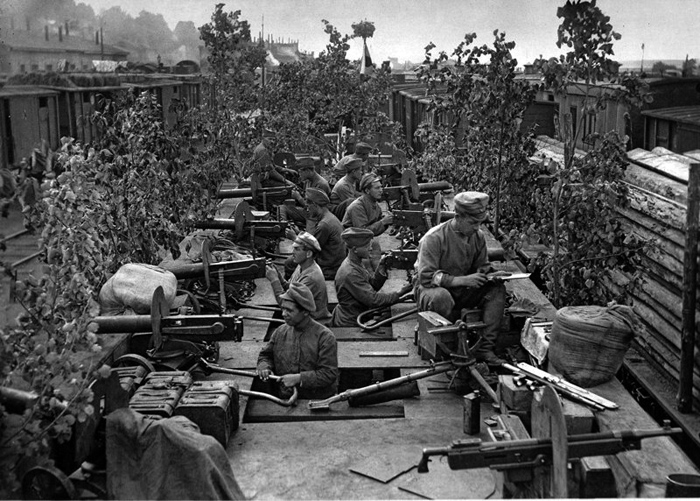
Czech legion showing how that are heavily armed, 1918
In brief, after some service with the Imperial Russian Army all along 1916 in the southern front, it was then captured and used by Ukrainian units of the Central Rada in 1917. After the revolution, it seems she was abandoned but not scuttled, and captured in January 1918 by a Bolsheviks expeditionary force led by Mikhail Artemyevich Muravyov. It was used for the start of the civil war but after just a month it was captured by a gang of anarchists and used to terrorize villages near Odessa.
It should be said that during the civil war, around 300 armored trains fought, but most were improvized and only 75 used standardized platforms adapted to Russian railways. Soldiers and sailors improvised protection on industrial flat cars with added wooden stockades and sandbags, even concrete or scrap metal and fitted old naval deck guns from the new rotting fleets of the Baltic and Black sea. The Bolsheviks had 23 of such armoured trains in 1918, and this was expanded to such a degree there were about 103 armoured and armed railway cars, sme self-powered, but they were rare, as the civil war ended by 1921. Zaamurets was by far the most advanced but was not relocated, except for the "Pekin" built by a warlord as a replica by the original engineers that created the first Zaamurets. Both were also confused for each others.
By 1919, armored trains were generally composed of one to three armed artillery cars, MG cars, support wagons and carried aboard raiding parties, generally a company of 165 men clearing out blocking enemy positions and providing a screen all around the train when it stopped. In some there was even a small 47 cavalry party to provided added mobility, reconnaissance inland and vanguard along the railway well in advance of the train to secure passage, deal with saboteurs. They could be accompanied by a machine-gun section on two horse-drawn Maxim MG carts for support. This proved instrumental in Ukraine in chaos by 1918, between German-backed nationalists and uncontrollable anarchist groups plus Local peasant uprisings.
Later, the Red Army recaptured it and it was soon directed for operations against the Czech legion. The latter however whe it arrived at Simbirsk (now Ulyanovsk) managed to ambush it and captured the train. Before it happened, the Train in March 1918 was combined with BP-3 which later was caotured by nationalists in Ukraine until derailed by anarchist guerrillas which captured it in turn. BP-3 was as much impressive as the main rail car of Zaamurets. BP-3 was one of the four Khunkhuz-class railway carriages built in Kiev in 1915, carrying 3-inch mountain guns and no less than 12 machine guns. The combo trained called BP N°4 was blasted by German artillery and had to back to Russia to be repaired. It soon returned to counter the Whites. At the time it was renamed "Lenin" and probably sported red flags.
"Olrik", the Czech Legion 1918-1921
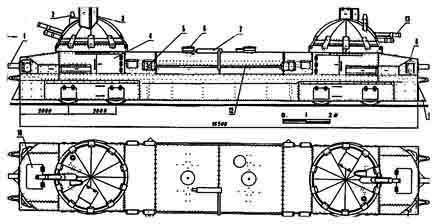
Olrik design 1919
The Czechoslovak Legion soon appeared in the picture. It was composed by nationalists willing to separate from the Austro-Hungarian Empire and fight against it as part of the Russian Army, a Legion created with ethnic Czech and Slovaks as early as October 1914. But in 1917 when Russia signed the Treaty of Brest-Litovsk this legion counted 40,000 men, well experienced and well armed, but they were stranded in Ukraine and planned to travel to France to continue the fight.
Tomás Masaryk of the Czechoslovak government in exile traveled to Russia to get both Bolshevik and Ukrainian nationalist evacuation greenlight. They planned a 6,000-mile journey to Vladivostok to be then tansported by boats to France to the condition they would remain neutral. But the self-defense exception went by the window as "friendly fires" multiplied and when on February 18, 1918, the Germans invaded Ukraine to fight the Bolsheviks, the Czech Legion was in their path of advance and they fought hard.
They eventually took refuge in Russia in March, and prepared to leave for Siberia having to deal with a completely overwhelmed railway network with two million POWs in Russia being moved, up to 20% percent of the workforce and to be transferred back to their home nations. However the Bolshviks forcibly impressed them in the red army to fight the Germans.
Tension in May raised a point at Chelyabinsk, when the Legion lynched a Hungarian POW which struck a legionnaire, but guards put back order, until the Chelyabinsk Soviets arrested them, not those responsible. To the eyse of the legion, these men about to be shot by firing squad were innocent. Overnight some 2,000 legionnaires seized the town, got 800 weapons from commissariats. Leon Trotsky which negociated to have this legion fighting for him was incensed and by May 21, ordered to disarm the Legion forcibly and had it disbanded. The Legion held a congress in Chelyabinsk and decided to fight their way to Vladivostok.
The Legion soon sensed it needed stations and railways, and started to create their own armoured trains with salvaged metal and guns to take control of the Trans-Siberian Railway. They fough the People’s Army of Komuch, and White Russians under Alexander Kolchak. Trotsky sent the "ultimate weapon" to clean up the railway, and this was Zaamurets.
Alas, Zaamurets already experienced by heavy fighting on the Southern Front, was reinforced by a second Khunkhuz-class railcar. The Legion prepared an ambush and decimated not only the Bolsheviks but foreign volunteers in Simbirsk. They eventually captured Zaamurets, renamed it Orlik ("Young Eagle"), and refitted it. Gone were the Nordenfelt guns replaced by 3-in M1902 Putilov field guns and plenty of ammunition. With their White Russian allies, the Legion with Olrik as flagship and a dozen otehr armoured trains "ruled the rails" from 1919 to 1920.
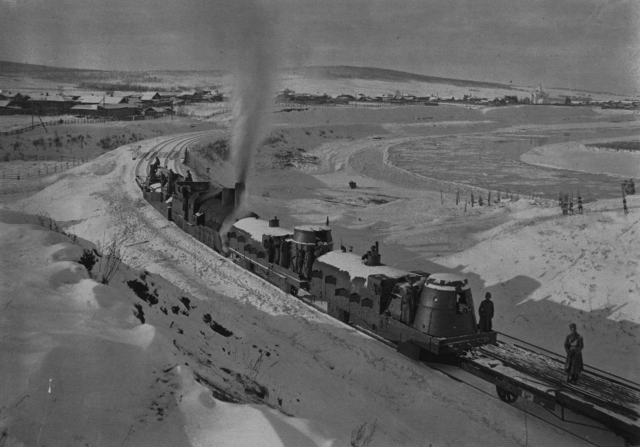
Olrik in the winter 1918-1919
The 1918 Armistice and 1919 Treaty of Versailles saw the creation of an independent Czechoslovakia and the Legion which now had a nation-state were desperate to come home. However the west was blocked by massive Bolshevik forces. In comparison, the contested east seemed a better option. So by early 1919, the Legion made it way to Vladivostok, leaving the Trans-Siberian Railway undefended with Bolsheviks hot on their tail. They betrayed Kolchak and delivered bith its train and the Tsarist gold bullion looted from Kazan, making a pact with the Red Army to be free to proceed eastward and leave the country.
So during the civil war, the legion retreated to Vladivostok with "Olrik", and went as far as Inner Mongolia crowded with evacuated White Russians. It almost reached Vladivostok but was intercepted by Japanese-controlled Hailar, Mongolia. The train was then temporarily taken by the Japanese after a fire incident, after the Japanese arrested several suspected Bolshevik sympathizers on the railroad leading to a gun battle and the Legion did not took part. The Japanese however which feared their disloyalty accused them to have let Olrik fire on them.
Japanese officers at Hailar were adamant they would keep the train as war prize, until a Czech diplomat convinced Gen. Shigemoto Oi to let the Legion have it back at Harbin after retained it for several months. Eventually it was returned to the Czech, which in between managed to reach a port to be evacuated back home after a very long trip by boats by September 1920.
The far east 1923-1931
The ex-Zaamurets, ex-Polipanovtsi (BP N°4), ex-Olrik, ex-Zaamurets, was now stranded in Harbin, in the hands of the White Russians in Siberia. The last White Russian redoubt in the region was given the train renamed "Zaamurets" again, but as the situation degraded, the Whites fled into China when the last outposts around Vladivostok fell in 1922 to the Reds (after the multinational coalition evacuated). The white Russian officer traded the train and other weapons to the Chinese warlord Zhang Zuolin which used it in the area.From now on, the mercenary train patrolled the Chinese Eastern Railway until 1924, until the volunteers decide to fight alongside Zhang’s Fengtian Army against the Japanese-backed Zhili Army. Zaamurets was repainted and renamed "Train No. 105", now in service of the warlord Zhang Zuolin until 1925, then it passed into the army of Zhang Xu Chan. The white Russian crew stayed to take care of the train, probably the best of all armoured trains in China. They later fought during the remainder of the warlord era, until the Japanese invasion in 1931.
The Tokyo-backed Kwantung Army captured it in 1931 and the IJA was interested to have it used to secure its colonies. It was to be deployed on the Mandchurian railroads that were the pretext for the Russo-Japanese war. The Kwantung Army used it to secure the railways, and it took part of the start of the second world war for some historians, which started with a Mandchurian incident. The same historians failed to document any photo, any record about the train after 1931. Hypothesis had been rampant ever since. Some argued it was was blown up and derailed as late as WW2. Or just discarded and scrapped...
Gallery

Early appearance, main artillery car fighting the Germans in Galicia, 1916

Second appearance as "Olrik", Siberia 1919.

Last appearance as "N°105", Mandchuria 1924.
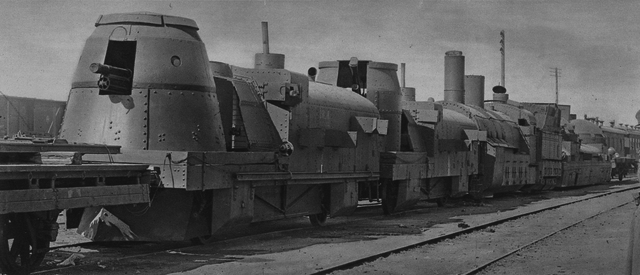
Olrik, winter 1818-19
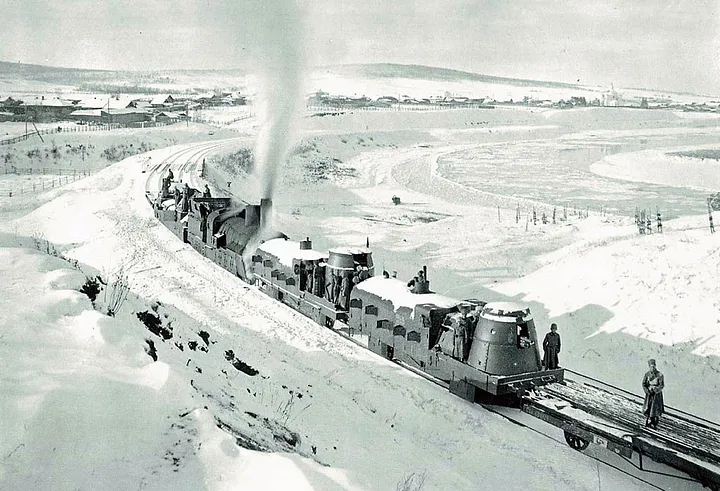
With the czech legion
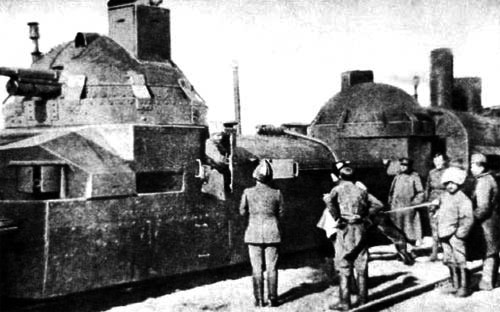
Olrik in 1920
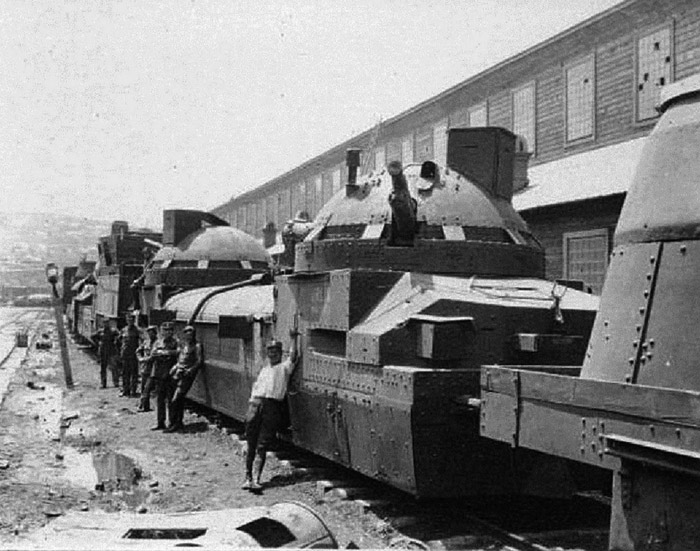
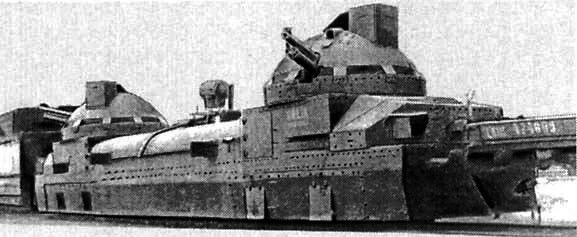
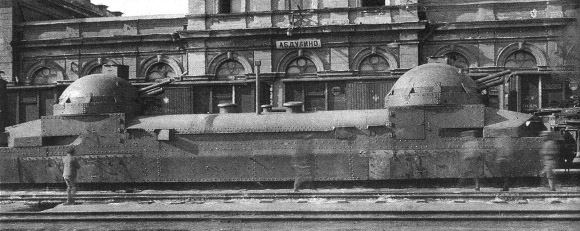

Sources

Armored trains by Steve Zaloga, Osprey Books.
taskandpurpose.com
en.topwar.ru
landships.activeboard.com
g1886.com
landships.info
paris33.org/guide/chinese-civil-war-armies
medium.com
tankarchives.ca
Videos
- Baldwin Railroad battery 1861
- No 6 Garrison Arm. Train 1894
- Ladysmith Train 1899
- Crewe Works 1915 coastal train
- French mobile artillery battery (1914)
- Royal Navy armoured Train 1914
- Regia Marina Arm. Trains 1915-18
- Ajmer arm. trains 1916
- Hungarian MAVAG train
- German Panzerzug Ost (1916)
- Bolshevik Armored Tram 1917
- Finnish Arm. Train (1918)
- Zaamurets (Orlík, BP-4, Lenin)
- Khunkhuz
- General Annenkov
- Yenisei
- Amur
- Terek
- Don
- Dywizja Syberyjska trains 1918
- Kozak
- Piłsudczyk
- PP3
- Gromobój
- Pionier
- Śmiały
- Lis-Kula
- Hallerczyk
- Stefan Batory
- Generał Iwaszkiewicz
- Chrobry
- Wilk
- Danuta
- Poznańczyk
- Kaniów
- Zawisza Czarny
- Zagończyk
- Paderewski
- Mściciel
- Reduta Ordona
- Huragan
- Podhalanin
- Bartosz Głowacki
- Pierwszy Marszałek
- Groźny
- Śmierć
- Śmigły
- Stefan Czarniecki
- Generał Sosnkowski
- Putilov armoured trains
- Izhorskiy Armored Train
- Czechoslovak Legion Trains
- Estonian Trains
- Lithuanian Trains
- Zhang Zongchang Train
- Danuta
- Poznańczyk
- Generał Sosnkowski
- Paderewski
- Śmierć
- Pierwszy Marszałek
- Piłsudczyk
- Śmiały
- Groźny
- Bartosz Głowacki
- Smok Kaszubski
- Drezyna R
- Drezyna TK/TKS
- UK dywizjon Trains
- SOK Draisines 1945
- Arm. draisine Crochat
- Austro-Daimler Draisine
- Armoured draisine Tatra T18
- MBV-2 Rail cruiser
- D-2 Draisine (MBV-31)
- D-37 Draisines
- Krasnaja Zvezda (KZ-1)
- D-3 Draisines
- BTD heavy Draisines (5)
- CB-1 Draisines
- DT-45 Draisines
- BD-41 Draisines (12)
- BA-I-Zhd Railcar
- BA-6ZhD Railcar
- BA-20ZhD Railcar
- BA-10Zhd Railcar
- VS-60 Train/Wagon
- BP-35L/H Train
- NKPS-42/Wagon Train (40)
- PL-35 Arty Wagon
- PL-37 Arty Wagon
- PT-35 Arty Wagon
- KV-1 Arty Wagon
- Crimean 76mm univ. Wagon
- "Tank" Wagon
- BP-42 Train/PL-42 Wagon (10)
- BP-43 Train/Wagon (54)
- 7.62mm Maxim SPU-BP Flak wagon (28)
- 37mm PVO-4 FLAK Wagon (120)
- OB-3 Light Wagon
- 27th Div armoured Trains
- 29th Div armoured Trains
- 48th Arm. Div armoured Trains
- "Stalinets" armoured Train
- "Mir Jafar Bagirov" armoured Train
- "Kozma Minin" armoured Train
- "Dzerzhinets" armoured Train
- "Za Rodinu!" armoured Train
- "Kolomensky Rabochy" armoured Train
- Zenitnyy (AA) armoured Trains
- Goering's Asien
- BP42 armoured train (full)
- BP44 armoured train (full)
- Panzerjägerwagen BP44
- BR 52, Steyr Schwerer Schienen Panzer
- Schwerer gustav Train
- P204(f) rail tank
- Schienenkampfwagen SK 1
- Schwerer Spähzug (s.Sp.) Artilleriewagen
- LeichteSchienenkampfwagen 43
- Zeppelin Panzer Draisine
- Panzertriebwagen N17
- Panzertriebwagen N16
- Panzer Draisine Funkwagen
- Panzerdraisine/Pz.III turm
- Panzerdraisine/Pz.IV turm
- Panzer Draisine Le.Sp.
- Panzer Draisine Flakvierling
- S.Panzer Draisine Kugelblitz
- L2670 leichtes panzertriebwagen
- AB Ferroviana
- Littorina OM 36
- LiBli 42
- Type K2 Steam Locomotive No.134
- Type C56 Steam Locomotive No.31
- Type 90 240 mm Railway Cannon (Futtsu Cannon)
- Type 91 Broad-gauge Railroad Tractor (So-Mo)
- Type 94 Armoured Train
- Type 95 Armoured Railroad Car (So-Ki)
- Type 98 Railroad Tractor
- Type 100 Railroad Tractor
- Type 2598 Railroad Car
- Rinji Soko Ressha 1933
- 1940 coastal defence Trains
- Royal Armoured Corps Trains
- Romney, Hythe and Dymchurch Train
- Malaya Arm. train 1942
- 101-104. sz. páncélvonat
- Finnish Winter War Train
- Croatian Armored Train
- Can. Aleutian No.1 Armoured Train
- Slovak resistance armoured train
- Iraqi armoured train (1941)
- Polish 1945-55 trains
- Arm. train La Rafale 1948
- Tren Blindado 1958
- Panser Rel V16 (1955)
- White Train 1957-87
- RT-23 Molodets ballistic wagon
- Trans-Siberian Arm. Train 1970
- North Korean Arm. Train
- Krajina express 1990
- Volga (2022)
- Baikal (2022)
19th Cent. Trains
WW1 Armored Trains
 Poland
Poland
Interwar Armored Trains
WW2 Armored Trains
 France
France
 Austria
Austria
 Czechoslovakia
Czechoslovakia
 USSR
USSR
 Nazi Germany
Nazi Germany
 Italy
Italy
 IJA
IJA
 UK
UK
 Others
Others
☢ Cold war Armored Trains
References
blog.railwaymuseum.org.ukarmedconflicts.com Russian Trains
warhistoryonline.com
feldgrau.com ww2 german trains
cuttersguide.com
wikipedia.org/wiki/Armoured_trains_of_Poland
derela.pl/drais
derela.pl/tatra.htm